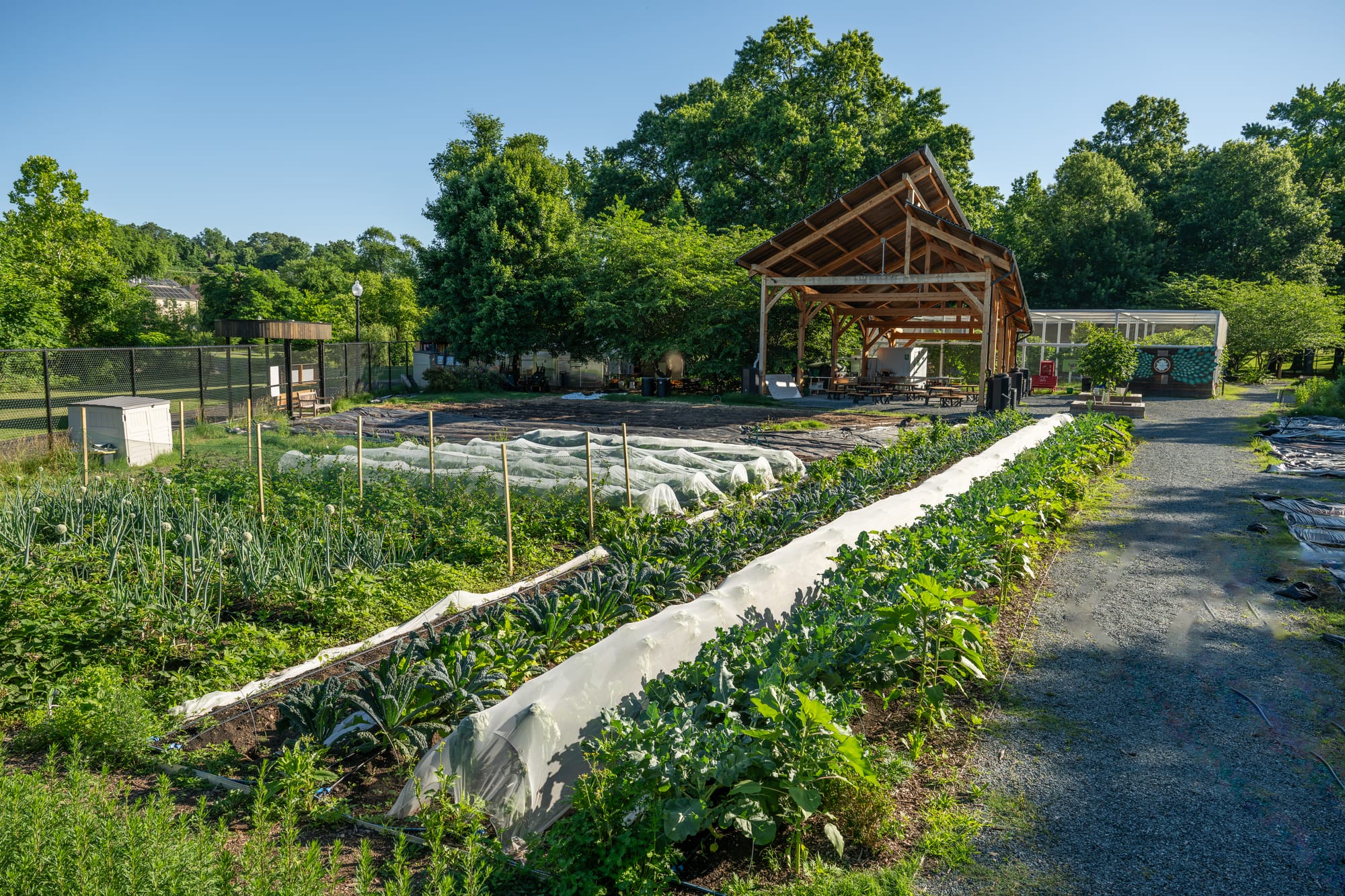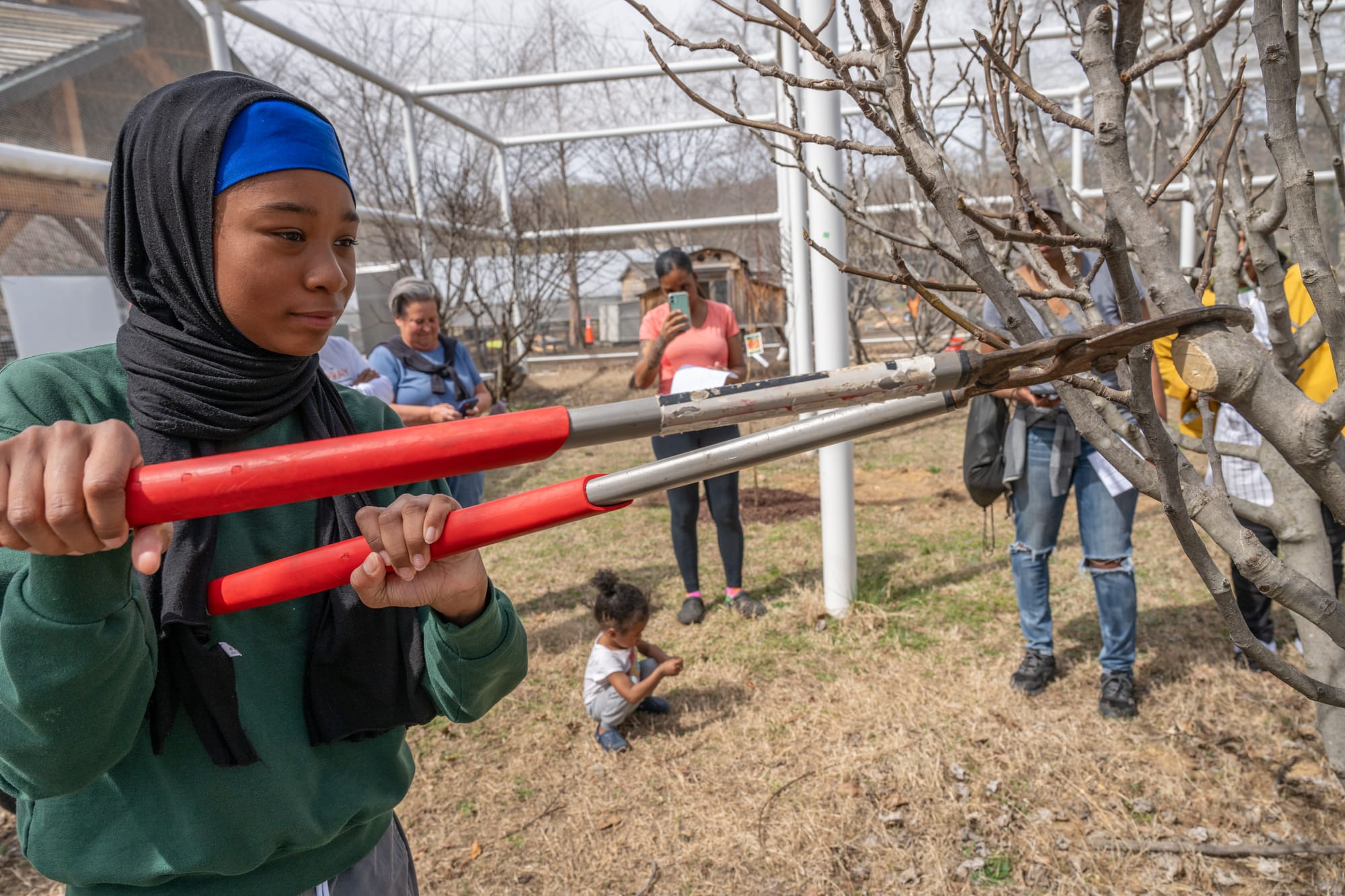Wilson Building Bulletin: The aftermath of McDuffie’s resignation
Also: a push to delay ranked choice voting fails and a lawmaker looks to restrict MPD cooperation with ICE.
D.C. faced record-breaking temperatures this year. We rounded up the best advice for gardening in a warming world.

When my husband and I moved to D.C. four years ago, my number one requirement was an outdoor gardening space. We found that in Petworth, which — to my pleasant surprise — is home to a robust plant community. Come springtime, it’s common to find neighbors exchanging seeds at the library, giving away extra sprouts on Facebook, and weeding their plots in preparation for a hot summer that generally yields an abundance of fruits and vegetables.
I got my start container gardening on a New York City apartment rooftop that wasn’t technically permitted for people (it was also the former home of a struggling model named Channing Tatum—gotta love New York). There, I nurtured a small farm of Thai chilis, sunflowers, and herbs in various pots scrounged up from sidewalks and discount stores. To now have a real backyard garden complete with cedar wood beds, a pollinator flower patch, and lots of native plants has been one of my greatest joys.
But in recent years, the impacts of a rapidly changing climate have made my hobby more challenging and less predictable. The District’s four distinct seasons have become more like two, with erratic and unpredictable swings between hot and cold. In 2024, the city experienced six 100-degree days and broke multiple records for high temperatures, ultimately clocking its third hottest summer on record. (For context, the city averaged less than one day above 100 degrees annually between 1991-2010.) By 2030, we can expect this to be the norm, with five to six such days annually, according to a report from D.C.’s Department of Energy and Environment (DOEE).
These conditions can create a host of issues for green thumbs: vegetables that bolt early making them tough and inedible, plants dropping their blooms before they can bear fruit, fewer pollinators, and more pests and disease.
“I’ve had the hardest time with tomatoes for the last two years. I’ve noticed [some tomato varieties] grow big, but they never set fruit,” says Petworth gardener Hannah Sheehy. “Mildew on my zucchini and cucumbers has also been a problem.”
These issues can cause months of hard work wasted, at best, and risk efforts to improve food security at worst. “When weather extremes or irregularities disrupt food production, it can undermine local food sovereignty by limiting access to fresh produce,” says Charles Rominiyi, manager at The Well at Oxon Run for DC Greens, a community farm and wellness space in Washington Highlands.
But even as the effects of climate change advance, there are strategies and tools to help make gardens more climate-resistant.
Setting up green infrastructure, which uses or mimics natural systems, can make a big difference. This includes things like installing rain barrels to sustain your garden during dry spells, adding rain gardens designed to better absorb precipitation, building driveways and patios with permeable pavers that collect stormwater, and planting shade trees to provide a canopy for smaller plants.
These economical improvements “combat pollution, erosion, and loss of habitat caused by stormwater runoff in a way that mimics the natural environment,” says Savanna Lightcap, an associate and representative from the Alliance for the Chesapeake Bay. “They can reduce flooding, support biodiversity, and make cities more livable.”
D.C. homeowners can apply for a stormwater audit through the DOEE’s RiverSmart Homes program, which offers financial and technical support for green infrastructure installations. After applying, a representative will assess your property in person or virtually and provide a report with recommendations in two to four weeks. DOEE can then connect you with a contractor to install the recommended features, often at little to no cost.
As rainfall intensifies (or disappears entirely) more often thanks to climate change, the risk of soil erosion (the wearing away of its top layer), nutrient run-off from extreme rainfall, and plant stress from soil that is too wet or too dry intensifies.
For example, maybe you’ve noticed your tomato plants flourishing one day, then suddenly dropping blooms like dead flies the next. This can happen as a result of heavy rains washing away nutrients from your soil, putting nutrient-craving plants like tomatoes at risk. It can also be due to extreme heat, which can put plants into survival mode, directing their resources to the roots and leaves instead of producing and sustaining flowers and fruit.
While the impacts of climate change might be unprecedented, addressing difficult horticultural conditions isn’t.
“It's known that our ancestors dealt with similar challenges during their time, and their practices can still be valuable today, even if conditions have evolved,” says Rominiyi, who recommends regenerative techniques for maintaining healthy soil such as composting and using native plants that “can help home gardeners adapt to shifting conditions.”
Learn the different options for backyard composting and what’s right for you. You can even get up to a $75 rebate for a backyard composting system.
Regenerative agriculture is based on Indigenous land management and ecological practices. Techniques like no-till planting (leaving the soil undisturbed when seeds or seedlings are planted), intercropping (growing two or more different types of crops next to each other), and crop rotation (switching up the plants you grow in an area each season) were widely used by Indigenous people long before European settlers arrived. One example is the Iroquois' “Three Sisters” method, where corn, beans, and squash support each other’s growth while enriching the soil. The corn stalks provide a natural trellis for the bean vines, the beans enrich the soil with nitrogen, and the large squash leaves act as a natural mulch by covering the ground and help to suppress weeds and maintain soil moisture.

Bees, butterflies, and even pesky house flies are as important to a fruitful garden as light and water. Without these little laborers transferring pollen between flowers, plant reproduction would be much harder – but they're facing growing threats.
“Declining pollinator populations have serious implications for food production,” says Thorne Rankin, Executive Director of DC Natives, a nonprofit that creates free pollinator gardens for District residents. “It impacts people’s ability to grow their own food as well as the biodiversity of our land and waterways.”
Research has found that climate change-related shifts — warmer winters, increased spring rain, hotter growing seasons — can reduce the abundance and diversity of native bees. One study in northeastern Georgia found that bee and butterfly populations decreased by around 60 percent in a 15-year period. Research also links the increase of impervious surfaces like sidewalks, roadways, and parking lots with reduced butterfly populations.
Gardeners can support pollinators in numerous ways, including planting native species like swamp milkweed, coneflower, black-eyed Susan, and bee balm, which absorb more stormwater than grass while also offering essential habitat and food. You can sign up to get a free pollinator garden from DC Natives. You can also do less garden cleanup. Fall leaves and decaying plants provide vital winter habitat, so delaying spring cleanup until May helps give pollinators a fighting chance.
Avoid leaf blowers as they disrupt pollinator habitats and species like bees that rely on sound to communicate. (While gas ones are already banned in the District, electric ones aren’t). Instead, try an old-fashioned rake, or do nothing and let nature take its course. It’s also important to use natural mosquito control alternatives, like eliminating standing water and using fans, instead of pesticides which take out pollinators along with mosquitos.
Warming temperatures means that pests and plant pathogens like Southern blight and powdery mildew are thriving further north. For D.C. gardeners, that means considering more plants that love heat like tomatoes, peppers, cucumbers, and okra. Similarly, you can plant varieties that are bred to better withstand disease like Black Turtle dry beans and Night Shadow eggplant.
Consider specific varieties, says Rick Naylor, who gardens at his home in Brookland. “Not all tomatoes or peppers will do well here. For example, hybrid tomato varieties like Momotaro, Mikado, and Katana that grow well in Japan grow well here because our climate is similar.”
When buying seeds for new varieties, look for keywords like heat tolerant, drought tolerant, pest resistant, and disease resistant

“It’s important for communities to continue learning and to understand how [climate change] disruptions can shape our food system,” says Rominiyi. “So they can develop strategies that build community resilience and help make healthy food available to everyone.” Check out The Well at Oxon Run’s calendar for events to learn things like how to start seedlings, blend herbal teas, and more.
You can also get a certificate from the DC Master Gardener program, which trains volunteers to help local communities by sharing gardening practices that are environmentally friendly, research-based, and culturally appropriate. Local colleges and universities also have resources. For example, The University of District of Columbia’s “Ask a Master Gardener” answers questions for free within 48 hours.
For next year, bookmark your calendar for the DOEE’s Rooting DC, a free annual conference offering workshops, networking, and exhibitor booths to help gardeners and food-system stakeholders connect and learn from each other.
With your help, we pursue stories that hold leaders to account, demystify opaque city and civic processes, and celebrate the idiosyncrasies that make us proud to call D.C. home. Put simply, our mission is to make it easier — and more fun — to live in the District. Our members help keep local news free and independent for all: